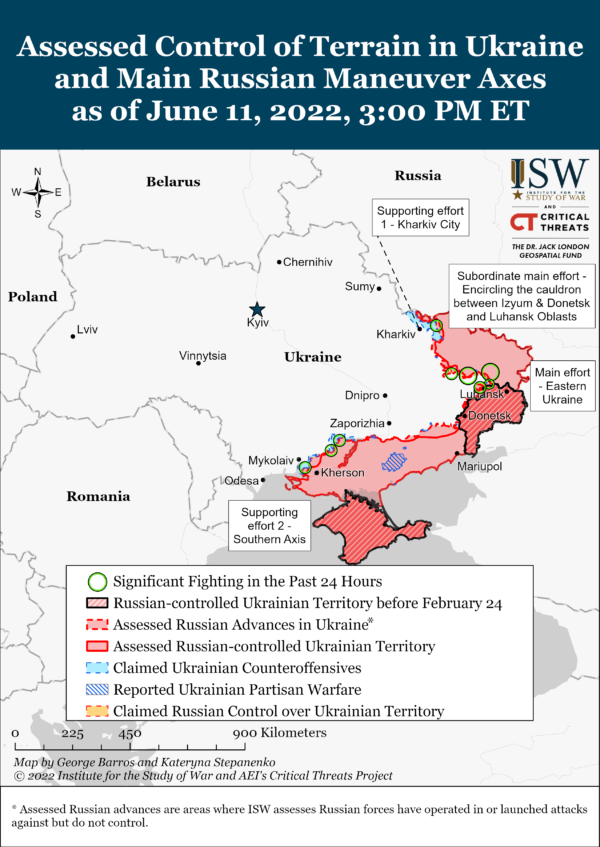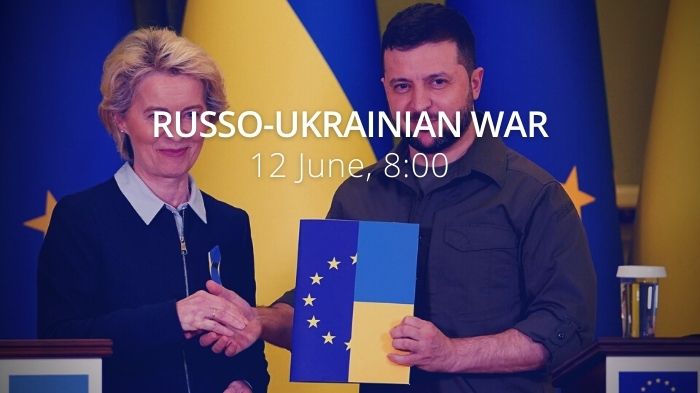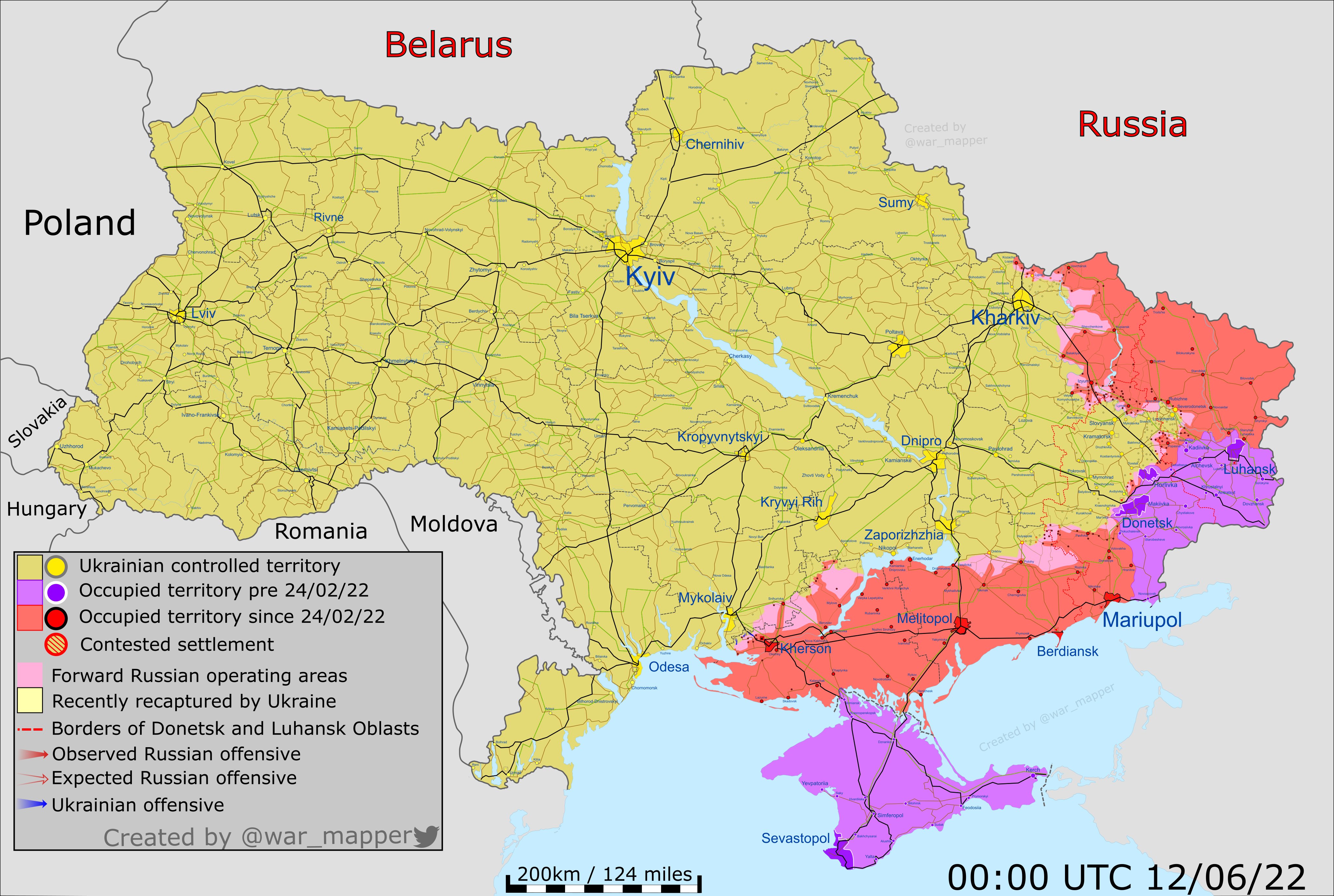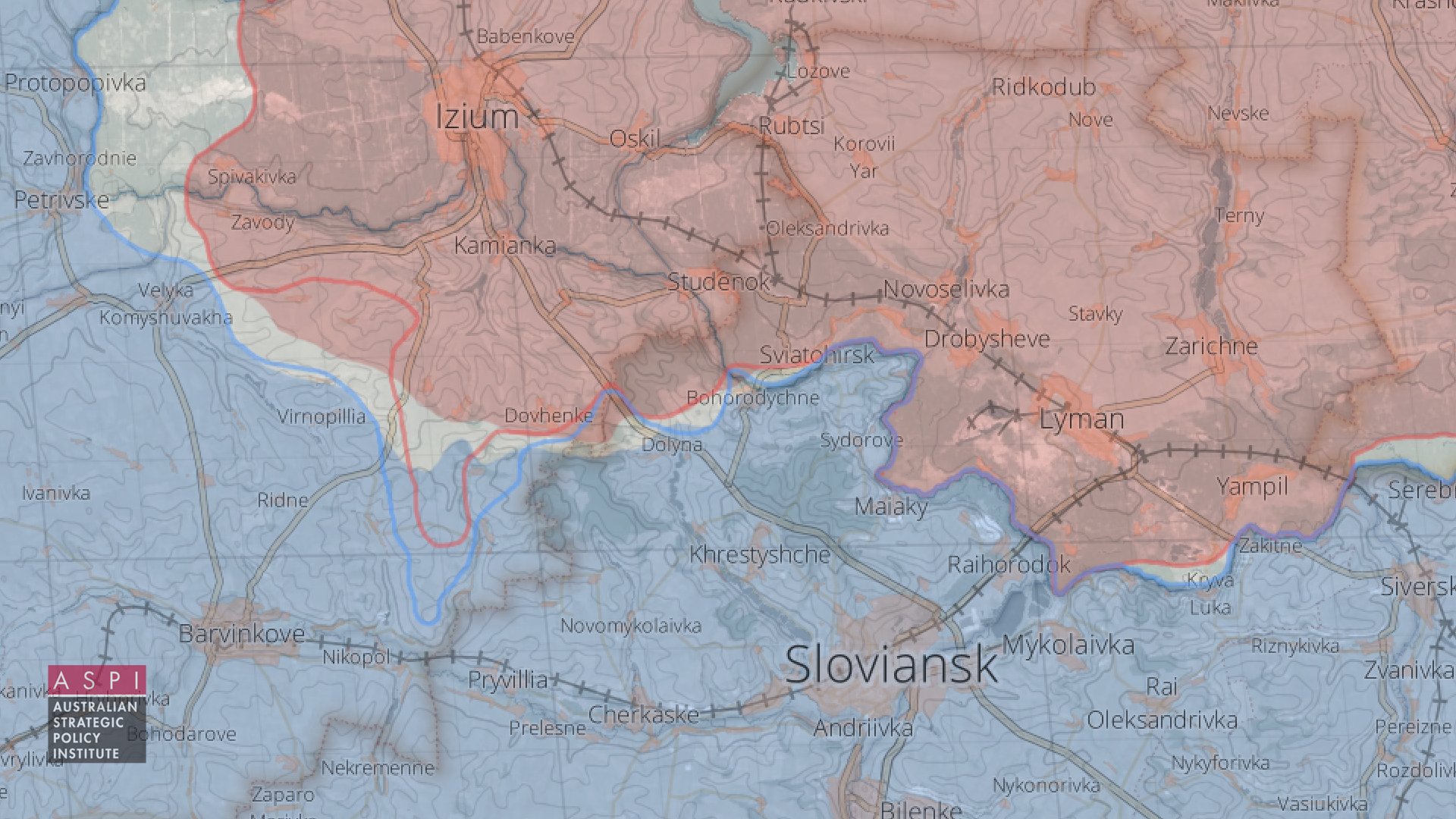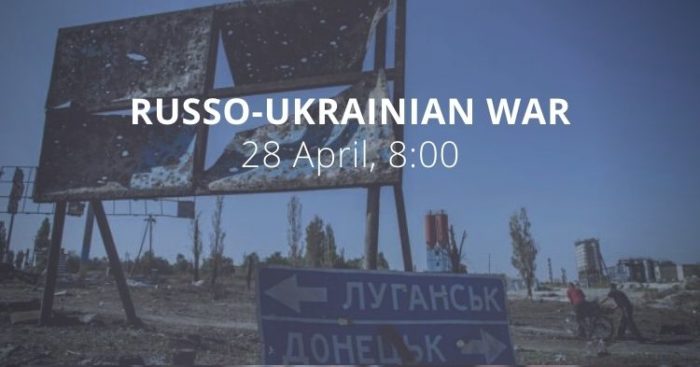Operational situation
In the background of active hostilities on the front, President of the European Commission Ursula von der Leyen visited Kyiv. According to her, the conclusion of the European Commission on Ukraine's application for EU membership will be ready by the end of next week.
Kharkiv Oblast. Russian troops from the areas of Kozacha Lopan and Ternova started attacking in the direction of Borshchova and Bayrak. They have an intention to get closer to Kharkiv.
Donetsk Oblast. North of the Sloviansk, Russian troops launched an offensive on a wide front, on the line Brazhkivka - Dolyna - Virnopilla. Ukrainians repelled this assault. There are also active battles around the Bohorodychne. Russians did not take active actions east of Sloviansk.
Luhansk Oblast. Russians estimate the number of Ukrainian troops in Sievierodonetsk at 400 people. According to Mayor Oleksandr Striuk, the Armed Forces control a third of the city. In general, the situation in the region is without change, which means only that the Russian offensive continues to slow down. They did not capture any important point and did not cut off the road to Lysychansk. Fierce battles took place on the same frontiers as yesterday.
Kherson Oblast. Russians announced they had captured the Kinburn peninsula, which is strange because it has been occupied for a long time and this is a reserve so there was no Ukrainian garrison, and accordingly - no one resisted. There is news about a counterattack by the Armed Forces of Ukraine on Kherson, in the directions of Kyselivka, Soldatske, and Oleksandrivka. The village of Tavriyske is already under Ukrainian control.
Update:
🇺🇦 are carrying out an offensive West of Kherson.
It has been confirmed that Tavrijs'ke is under 🇺🇦 control. pic.twitter.com/hjlS3VNPlu
— War Mapper (@War_Mapper) June 12, 2022
It seems that the Ukrainian command initially diverted the enemy's attention to the Davydiv Brid area, forcing the Russians to send additional forces there and start attacking the positions of the Armed Forces on the left flank of Inhulets. And while the Russian troops were concentrating there, Ukrainian troops struck in a completely different direction. However, so far there is no news about the successful advance of Ukrainian troops. Russian troops counterattack in the area of Kyselivka. They have well-fortified approaches to Kherson, so there will be no quick breakthrough. There also was information about fighting around Snihurivka.
In the village of Stara Zburivka, two Russian generals and many officers and soldiers were killed as a result of a Ukrainian air strike on the night of June 10.
Zaporizhzhia Oblast. Battles happened near the Vasylivka-Orikhiv highway, near the villages of Shcherbaky and Mali Shcherbaky. It is unclear whether this is a Ukrainian offensive in this direction or just local fighting. Interestingly, yesterday President Zelenskyy said that "we have a certain positive [developments] in the Zaporizhzhia Oblast, where we manage to thwart the plans of the occupiers." However, some details of these positive developments have not been made public.
Information from the General Staff as of 06.00 11.06.2022, supplemented by its [18:00 assessment], is in the drop-down menu.
In the Siverskyy direction, the enemy continues to provide enhanced protection of the Ukrainian-Russian border in the Bryansk and Kursk regions. Increased levels of terrorist threat were prolonged in Belgorod and Kursk oblasts. The enemy continues to fire mortars at the positions of the Defense Forces in the border areas. In addition, the aggressor fired on civilian infrastructure in the areas of Rozhkovychi, Hremiach, Luhivka, and Popivka.
The situation in the Kharkiv direction has not changed significantly. To restrain the actions of the defense forces, the enemy exerts systematic fire on the positions of our units. In addition, the enemy fired on civilian infrastructure near Virnopillia, Ukrayinka, Petrivka, Chepil, and Khrestyshche. It conducted an air strike near the village of Mospanovo.
In the Sloviansk direction, the enemy carried out systematic artillery shelling in the areas of the settlements of Petrivske, Nova Husarivka, Kurulka, and Dolyna. It is trying to gain a foothold in the village of Bohorodychne, where the fighting continues. Ukrainian soldiers successfully repulsed an enemy assault in the areas of Brazhkivka, Dolyna, and Virnopilla.
The enemy did not take active action in the Lyman direction. It increased the intensity of artillery use, including multiple rocket launchers, in the areas of Shypylivka and Dronivka, regrouped troops.
In the Sievierodonetsk direction, the occupiers are conducting assaults in the city of Sievierodonetsk without progress. Part of the enemy units are assaulting the Toshkivka area, and fighting continues.
In the Bakhmut direction, the enemy fired at our positions with mortars, artillery, and MLRS in the areas of the settlements of Komyshuvakha, Hirske, Mykolayivka, Bilohorivka, and Novoluhanske. Enemy aircraft struck near Pokrovske.
Ukrainian soldiers repulsed the offensive near the village of Vrubivka. The enemy also tried to advance in the direction of the settlement of Mykolayivka but received a decisive rebuff and left. Our defenders also successfully repulsed the enemy assault in the Vasylivka area. The Russian occupiers suffered losses and retreated to their former positions.
The enemy did not conduct active hostilities in the Avdiivka, Kurakhiv, Novopavliv, and Zaporizhzhia areas. It fired on civilian infrastructure in the areas of Zhelanne, Avdiivka, Karlivka, Vuhledar, and Orikhiv, and deploys additional units in some areas.
In the Pivdennyi Buh direction, the enemy conducts defensive actions, firing at units of our troops with artillery, mortars, and MLRS. He tried to strike the artillery battery.
The Russian occupiers cynically shelled the settlements of Tverdomedovo, Bereznehuvate, Kobzartsi, Kvitneve, and Luch. Over the past 24 hours, the enemy has lost ten tanks, sixteen armored combat vehicles, seven UAVs, more than ten vehicles, and up to 150 manpower.
As of Sunday 12 June, the approximate losses of weapons and military equipment of the Russian Armed Forces from the beginning of the war to the present day:
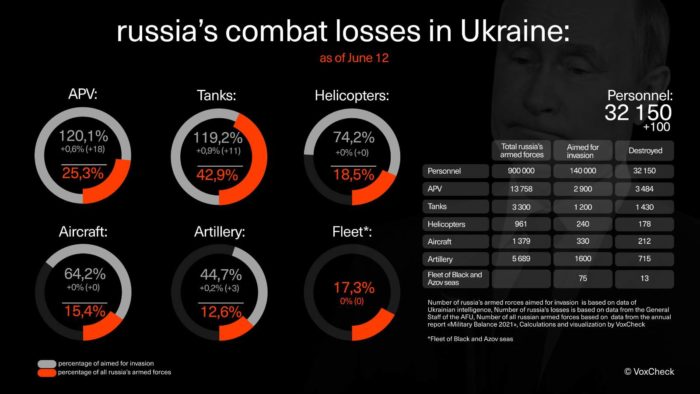
- Personnel – more than 32150 (+100),
- Tanks – 1430 (+11),
- Armoured combat vehicles – 3484 (+18),
- Artillery systems – 715 (+3),
- Multiple rocket launchers –MLRS – 226 (+4),
- Air defence means – 97 (+0),
- Aircraft – 212 (+0),
- Helicopters – 178 (+0),
- Automotive technology and fuel tanks – 2455 (+7),
- Vessels/boats – 13 (+0),
- UAV operational and tactical level – 582 (+3),
- Special equipment – 54 (+0),
- Mobile SRBM system – 4 (+0),
- Cruise missiles – 125 (+0)
Locals ignored pompous "Russia Day" celebrations in occupied Kherson, Regional Head Samoilenko said. "There are at most 30 or 40 Khersonians there. Hard to imagine a more shameful shame for Russia." Earlier, only 23 locals, including the quisling governor, accepted a Russian passport.
https://twitter.com/EuromaidanPress/status/1535974436867825665
Explosions in occupied Berdiansk reportedly destroyed Russian military vehicles.
Three explosions were heard in occupied Berdiansk around 7 AM, a part of the city was left without power. Quisling officials said that "two pops" and fire had taken place at a transformer station. According to a local telegram channel, the explosions destroyed Russian military vehicles stationed on the territory of the transport department of the former First-May factory.
Three explosions were heard in occupied Berdiansk around 7 AM, a part of the city was left without power
Quisling officials said that "two pops" & fire had taken place at a transformer stationhttps://t.co/GhPRvJERzs pic.twitter.com/WetIOvQuSx
— Euromaidan Press (@EuromaidanPress) June 12, 2022
Unknowns tried to blow up the Druzhba oil pipeline in Russia's Briansk Oblast, Baza reported. Three explosions happened in Gulevka, 40 km from the Ukrainian border, early morning on 11 June. A transformer substation and protective anti-dig pipe were damaged, the pipeline itself was not.
A Russian military facility was on fire in Klintsy, Bryansk Oblast, Russia, on 11 April. The facility is reportedly a base for the battle-damaged equipment that needs repairs. Klintsy lies about 50 km away from the Ukrainian border.
https://twitter.com/EuromaidanPress/status/1535578763907551236
Russians destroyed 2 bridges to Sievierodonetsk and are now shelling the last 3d one, RegHead Haidai said. The situation is very difficult, Russians spare no effort to cut off the city, Ukraine controls the industrial area of Sievierodonetsk but the Azot ammonium plant is constantly under fire. Haidai also said that Ukrainian troops took out a command post of Kadyrov's troops in Rubizhne. Earlier, Ukraine destroyed a base of the Wagner PMC in Kadiivka and ambushed a meeting of Russians at the Khimiki palace in Sievierodonetsk.
Russian missiles launched from Black Sea hit Chortkiv (Ternopil Oblast). There were 4 hits around 22.00 on 11 June; part of a military object & 4 5-story apartment buildings, gas line are destroyed. 22 people are injured, including 1 child.
Russian occupiers deployed new air defense systems on Zmiinyi [Snake] Island, satellite images show. Reportedly, they are Tor missile systems.
Russia's fleet in Black Sea increases to 4 landing ships - Operational Command South. 40 cruise missiles carried by the fleet pose an additional danger.
Russia continues random cross-border fire attacks on Chernihiv Oblast - Ukraine's Operational Command North. On 11 April, the Hremiach area was shelled with heavy artillery, then with heavy mortars. Mykhalchyna Sloboda came under mortar fire too.
Humanitarian
Over 2.5 million Ukrainians have returned to Ukraine since the war started - Frontex European Border and Coast Guard Agency. According to the agency, 5.5 million Ukrainian citizens have fled to the EU since the beginning of the war in February.
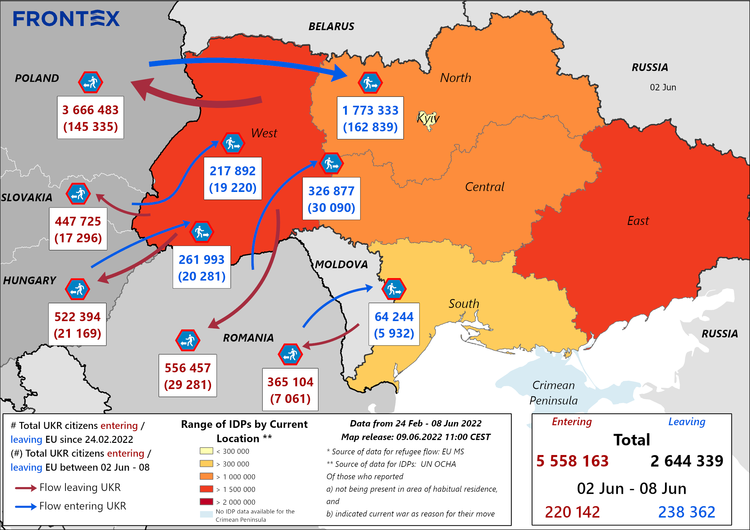
Environmental
Trusting Putin’s promises on grain corridors without credible military guarantees is "kamikaze" for Ukraine, German agriculture minister Özdemir said, Euractiv reported. Ukraine cannot count on Putin to honour his word and grant safe passage to grain vessels, German agriculture minister Cem Özdemir said during a visit to Kyiv on Friday, where he also promised fresh funds to support alternative export routes.
To boost efforts to bring Ukrainian wheat out of the country via the Danube, the minister promised fresh funds to finance expanding laboratory capacities in the Ukrainian city of Izmail, located on the river’s bank near the Romanian border, in order to minimise ships’ turnaround times at the border.
Meanwhile, the main focus of Özdemir’s meeting with his Polish counterpart, Henryk Kowalczyk, the day before had been on strengthening grain exports by rail. In this area, Poland, the largest EU country neighbouring Ukraine, has become an important logistic hub.
Speaking after the meeting, Kowalczyk said as a country directly bordering Ukraine, Poland had a “special responsibility” to provide help in exporting agricultural goods. He also announced he would host Ukrainian minister Solsky in Warsaw soon to discuss export logistics.
Despite these efforts, as well as those of the EU, which recently launched so-called “solidarity lanes” to help strengthen alternative export routes for Ukrainian wheat, logistical as well as bureaucratic hurdles have been impeding grain transport by rail.
Still, any solution other than a reopening of Black Sea trade routes is “a second- or third-best solution,” Özdemir said, stressing that, even if used to a maximum, “rail and road or river transport will not solve this problem.”
This mirrored a point made by Ukrainian deputy agriculture minister, Markiyan Dmytrasevych, in a recent interview with EURACTIV, where he stressed that, while well-intentioned, efforts to create alternative export routes would never be able to match the capacities of transport via the Black Sea.
“The main issue is to help Ukraine become sovereign and independent again and return to world markets,” Özdemir concluded.
Ukraine may not have enough facilities to store the harvest the next fall - Ukrainian PM Denys Shmyhal. He says the gov't is negotiating with partners on the construction of mobile grain storage facilities. Ukraine can harvest up to 10-15 mn t of grain this year.
Ukraine can't trust Putin's promises to not attack coast through grain corridors, Ukraine's MFA tells African Union. "We've learned the lesson that President Putin’s words can't be trusted," MFA spox Oleh Nikolenko said, replying to African Union's call to "demine Odesa to ease wheat exports." He also urged the African Union to use its leverage on Russia to convince it to stop its hostilities. Earlier, the AU chair urged to demine Odesa port to east wheat exports.
Legal
UN Commission arrives in Ukraine to investigate Russian war crimes. The Independent International Commission of Inquiry will gather evidence and report it to the UN Human Rights Council; they will also deliver a report to the UNGA at its 77th session.
Russian invaders demand Ukrainians have ‘filtration’ stamps and permits to live in their own cities - KHPG. The Russian invaders who have seized control of Mariupol are forcing the remaining residents to carry stamps in their passports, confirming that they have undergone so-called ‘filtration’, as well as passes ‘allowing’ them to move around their own city. A huge number of other residents of Mariupol and other cities Russia is currently occupying have been sent to so-called ‘filtration camps’, where men and women are held in appalling conditions and subjected to interrogation for the Russians to establish their political ‘reliability’. The fate of those deemed ‘unreliable’ remains unclear, however Russia has already killed several people that the invaders abducted, so there are clearly grounds for concern.
Russia started to give out its passports in occupied Kherson and Melitopol. According to Russian media, 25 Khersoners have received Russian passports, and the "first Russian passports" were given out in Melitopol, Zaporizhzhia Oblast.
Support
European Commission President Ursula von der Leyen traveled to Kyiv on Saturday to discuss Ukraine’s bid to join the EU with President Volodymyr Zelenskyy - Politico
Von der Leyen, on her second visit to Kyiv since Russia’s February invasion of Ukraine, indicated that the Commission should be able to complete its assessment of whether the country should be granted candidate status to join the EU within the coming week.
"The discussions today will enable us to finalize our assessment by the end of next week," Von der Leyen said in a statement, while stressing that the process "is a merit-based path forward." Ukraine has "done a lot in strengthening the rule of law, but there still needs to be reforms implemented, to fight corruption for example," she said.
Von der Leyen has championed Ukraine’s bid, saying there’s no question that the country belongs in “the European family.”
France hints at halfway decision for Ukraine candidate status- Euractiv. A decision to give Ukraine candidate status to the European Union has to be done without weakening the bloc and to ensure Kyiv is not left in limbo for years, a French presidential official said on Friday.
Three European diplomats said the most likely scenario was that the Commission, which will also give recommendations for Moldova and Georgia, would give its green light, possibly with conditions. The heads of state would then in all likelihood find a “formula” that would stop short of giving Ukraine candidacy status for now, the diplomats said.
“The philosophy has changed now. Nobody clearly says no, but those states that are lukewarm want to postpone as much as possible,” a European diplomat said.
The United States has called for a boycott of the economic forum in St. Petersburg. A State Department spokesman said the US government would not participate in the St. Petersburg International Economic Forum in any form. "The US Government will not attend the St. Petersburg International Economic Forum in any capacity. We urge governments and companies to join our boycott and send a clear message that there is no “business as usual” while Russian forces brutalize Ukraine," Ned Price, the State Department Spokesperson, tweeted.
Some German Marder IFVs that were modernized at the Rheinmetall factory can be "immediately" shipped to Ukraine, according to the factory's CEO, Bild reported. However, the federal government would rather send them to Greece in exchange for its Soviet ancient vehicles going to Ukraine. The Federal Government decides when and where the Marders are to be delivered. 88 Leopard 1 tanks and other Leo 2 tanks are also in the depot for modernization.
Germany rejected the Spanish idea to send 40 Leopard tanks to Ukraine, Spiegel reported, citing sources in the German government. It appears that the plan was not an official Spanish one. "In addition, the federal government had warned the Spaniards in telephone calls that this step would be a departure from the (albeit completely informal and unofficial) decision taken by all Western allies not to supply Kyiv with tanks. Apparently, the project leaked out in Madrid before someone in the Spanish government who was familiar with the subject was involved, the federal government said somewhat mockingly."
Rolls-Royce handed over two powerful generators to Ukraine. One of these can ensure the operation of several hospital buildings. The generators have already been distributed & sent to health facilities.
Taiwan to allocate $1.2 mn to rebuild Ukrainian temples destroyed by Russia, announced Taiwanese Foreign Minister Joseph Wu during an online meeting with Metropolitan of the Orthodox Church of Ukraine Epiphanius
German Chancellor Olaf Scholz, French President Emmanuel Macron & Italian Prime Minister Mario Draghi, plan to visit Ukraine ahead of the G7 summit
- Bild. "Scholz, Macron & Draghi want to demonstrate European unity with their trip"
QinetiQ Corporation sent Ukraine a batch of sapper robots TALON. These controlled robotic systems are widely used to mitigate risks from explosives & chemical warfare. QinetiQ team has trained over 100 Ukrainian soldiers in TALON operations in the last 8 years.
Ukrainian Army receives new Starlink satellite communications systems from Elon Musk.
New Developments
- Kremlin plans to create a single federal district out of occupied Ukraine regions - Meduza citing a source in the Putin administration. This district will appear after "referendums" are held; some say Kremlin official Boris Rapport was tapped to supervise its creation. In another publication, Meduza reports that sham referendums by which the Kremlin plans to annex occupied regions could take place in mid-July or on September 11. As they require the presence of Russian troops in every settlement, a "mobilization" of retired contract soldiers and army reserves is ongoing. As well, the Kremlin is developing a "patronage" system for occupied Ukrainian cities. It will involve providing financial assistance for their restoration and appointment of regional- and municipal-level Russian officials to relevant positions in the Donbas.
- Former Vice-President of Russia's Gazprombank Igor Volobuev joins the “Free Russia Legion," a military unit created for former Russian servicemen to fight against the Russian invasion. Volobuev, who fled Russia in April and joined the Territorial Defense of Ukraine, encourages all Russians “who hate the Putin regime to join.” Volobuev was born in Ukraine but received Russian citizenship during the collapse of the USSR.
- Biden Says Zelenskyy Brushed Off Warnings of Russia’s Invasion. US President Joe Biden says Ukrainian President Volodymyr Zelenskyy "didn't want to hear" US intelligence warnings ahead of Russia's invasion of his country. Mr Biden's remarks came during a Democratic fundraiser in Los Angeles, as he was talking about his work to rally and solidify support for Ukraine as the war continues into its fourth month.
Assessment
The Institute for the Study of War has made the following assessment as of Saturday 11 June:
Ukrainian officials continued to increase their requests for Western offensive and defensive equipment, particularly regarding capabilities necessary to combat Russian artillery superiority. Head of the Ukrainian Northern Operational Command Dmytro Krasilnikov reported that Ukrainian forces are experiencing a shortage in long-range artillery systems, while Russian artillery continues to overpower Ukrainian infantry. Ukrainian Advisor to Cabinet of Ministers Oleksandr Danylyuk stated that Russian forces adopted a new unspecified strategy that allows them to make more careful maneuvers. Key Takeaways Russia is planning to starve Asians and Africans in order to win its war in Europe, historian Timothy Snyder says in a twitter thread. "Russia has a hunger plan. Vladimir Putin is preparing to starve much of the developing world as the next stage in his war in Europe. In normal times, Ukraine is a leading exporter of foodstuffs. A Russian naval blockade now prevents Ukraine from exporting grain. If the Russian blockade continues, tens of millions of tons of food will rot in silos, and tens of millions of people in Africa and Asia will starve. The horror of Putin's hunger plan is so great that we have a hard time apprehending it. We also tend to forget how central food is to politics. Some historical examples can help. The idea that controlling Ukrainian grain can change the world is not new. Both Stalin and Hitler wished to do so. For Stalin, Ukraine's black earth was to be exploited to build an industrial economy for the USSR. In fact, collectivized agriculture killed about four million Ukrainians. Notably, as people began to die in large numbers, Stalin blamed the Ukrainians themselves. Soviet propaganda called those who drew attention to the famine "Nazis." Actual Nazis had related ideas. They liked the idea of controlling Ukrainian agriculture. This was in fact Hitler's central war aim. Hitler wished to redirect Ukrainian grain from the Soviet Union to Germany, in the hope of starving millions of Soviet citizens. The Second World War was fought for Ukraine and in considerable measure in Ukraine, between dictators who wanted to control food supplies. Russian memory politics prepared the way for a 21st-century hunger plan. Russians are told that Stalin's famine was an accident and that Ukrainians are Nazis. This makes theft and blockade seem acceptable. Putin's hunger plan is, I believe, meant to work on three levels. First, it is part of a larger attempt to destroy the Ukrainian state, by cutting off its exports. Putin's hunger plan is also meant to generate refugees from North Africa and the Middle East, areas usually fed by Ukraine. This would generate instability in the EU. Finally, and most horribly, a world famine is a necessary backdrop for a Russian propaganda campaign against Ukraine. Actual mass death is needed as the backdrop for a propaganda contest. When the food riots begin, and as starvation spreads, Russian propaganda will blame Ukraine, and call for Russia's territorial gains in Ukraine to be recognized, and for all sanctions to be lifted. Russia is planning to starve Asians and Africans in order to win its war in Europe. This is a new level of colonialism, and the latest chapter of hunger politics." 